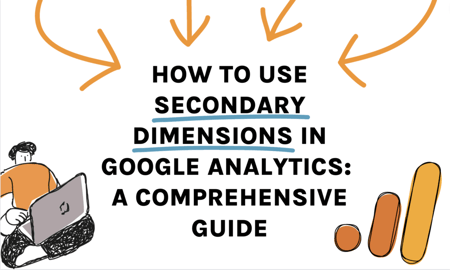Enhance Your Data Analysis Utilizing Second Dimensions
The true depth of understandings exists in the combination of second dimensions. The calculated usage of second measurements elevates analysis past the surface degree, assuring a wealth of untapped prospective waiting to be uncovered.
Comprehending Additional Measurements
Second dimensions in data evaluation refer to added attributes or metrics that supply much deeper insights when integrated with primary data measurements, improving the total understanding of the dataset. These added measurements supply an even more comprehensive view of the information, enabling experts to reveal surprise patterns, connections, and trends that might not be apparent when only taking into consideration primary dimensions.
By including additional dimensions into information evaluation, analysts can obtain a much more nuanced understanding of the elements affecting the key metrics. In marketing analysis, primary measurements can consist of basic client demographics like age and gender, while additional dimensions can incorporate variables such as buying actions, choices, or geographical area. By integrating these key and secondary measurements, experts can produce extra in-depth client profiles, allowing even more targeted and effective advertising approaches.
Moreover, secondary dimensions can assist in determining connections in between different variables, bring about more exact predictive modeling and decision-making. They allow analysts to check out information from several point of views, enhancing the insights drawn from the dataset and eventually boosting the top quality of evaluation and strategic suggestions.
Advantages of Secondary Dimensions
When taking into consideration information evaluation, incorporating secondary measurements uses a multitude of benefits that significantly improve the deepness and breadth of insights stemmed from main information measurements. One of the essential benefits of secondary measurements is the capability to give context to primary information. By including secondary dimensions such as time, area, or demographic info to the evaluation, researchers can get a more extensive understanding of the main data factors - secondary dimensions. This contextual information can aid identify patterns, fads, and correlations that may have or else gone undetected.
Furthermore, secondary measurements can likewise assist in segmenting data, allowing for a more in-depth analysis of specific parts within the main data. This segmentation can bring about even more targeted approaches and activities based upon the special qualities of each sector. Furthermore, additional measurements can help in confirming searchings for from primary data measurements, providing a much more trusted and robust basis for decision-making.
In essence, the benefits of incorporating additional dimensions right into data evaluation are indispensable, supplying richer insights and enabling even more enlightened decision-making procedures.
Executing Second Dimensions Successfully
Efficient implementation of second dimensions in data analysis needs a critical technique that maximizes the energy of additional contextual info. When including second dimensions, it is vital to align them with the main measurements to obtain deeper insights right into the information. Start by plainly defining the purposes of the analysis to determine which additional measurements will certainly supply one of the most appropriate context. It is important to select second measurements that match the primary information without creating noise or complication in the evaluation.
Additionally, consider the scalability of the additional dimensions throughout various datasets or analyses. By implementing second measurements efficiently, analysts can improve the deepness and precision of their data analysis, leading to even more enlightened decision-making and workable understandings.
Advanced Techniques With Second Dimensions
For an extra sophisticated method to data evaluation, integrating additional measurements can significantly elevate the deepness of insights obtained. Advanced strategies with secondary dimensions involve even more intricate techniques to remove valuable information from information collections. One such technique is accomplice evaluation, where data is segmented based on details characteristics or behaviors to track patterns gradually. This technique allows for a much deeper understanding of exactly how various teams progress and connect with your product Get More Info and services.
An additional innovative strategy is regression analysis, which assists identify relationships between variables and how they affect each other. By including secondary dimensions, such as group information or user actions, to regression models, you can discover a lot more nuanced understandings Our site and make more exact predictions.

Study: Secondary Measurements in Activity

In one more circumstance, a doctor leveraged secondary measurements to optimize source allotment. By examining individual outcomes in relationship to geographical area, the company determined areas with high readmission prices. This caused the execution of targeted intervention programs in those areas, inevitably enhancing patient treatment and minimizing health care costs.
These situation researches show the power of second dimensions in uncovering useful understandings that drive tactical decision-making. By diving deeper into data analysis beyond key metrics, organizations can gain an extra extensive understanding of their procedures and consumers, causing more enlightened and reliable service approaches.
Final Thought
To conclude, the unification of second dimensions in information analysis is necessary for obtaining a thorough understanding of underlying fads and variables. By utilizing methods such as mate analysis and regression evaluation, organizations can uncover surprise insights and make more enlightened decisions. Secondary dimensions add deepness and breadth to data evaluation, enabling organizations to discover data from numerous perspectives and drive more effective results.
In marketing evaluation, main dimensions might include standard customer demographics like age and gender, while second dimensions might incorporate variables such as buying habits, preferences, or geographic location.When considering information evaluation, integrating secondary dimensions supplies a multitude of benefits that substantially improve the depth and breadth of insights obtained from main data measurements.Moreover, additional measurements can also assist in segmenting information, enabling for an extra comprehensive analysis of details parts within the click for info main data. Furthermore, additional measurements can assist in validating searchings for from primary data measurements, offering a more robust and dependable basis for decision-making.
When including additional measurements, it is important to straighten them with the primary measurements to obtain deeper insights into the information.